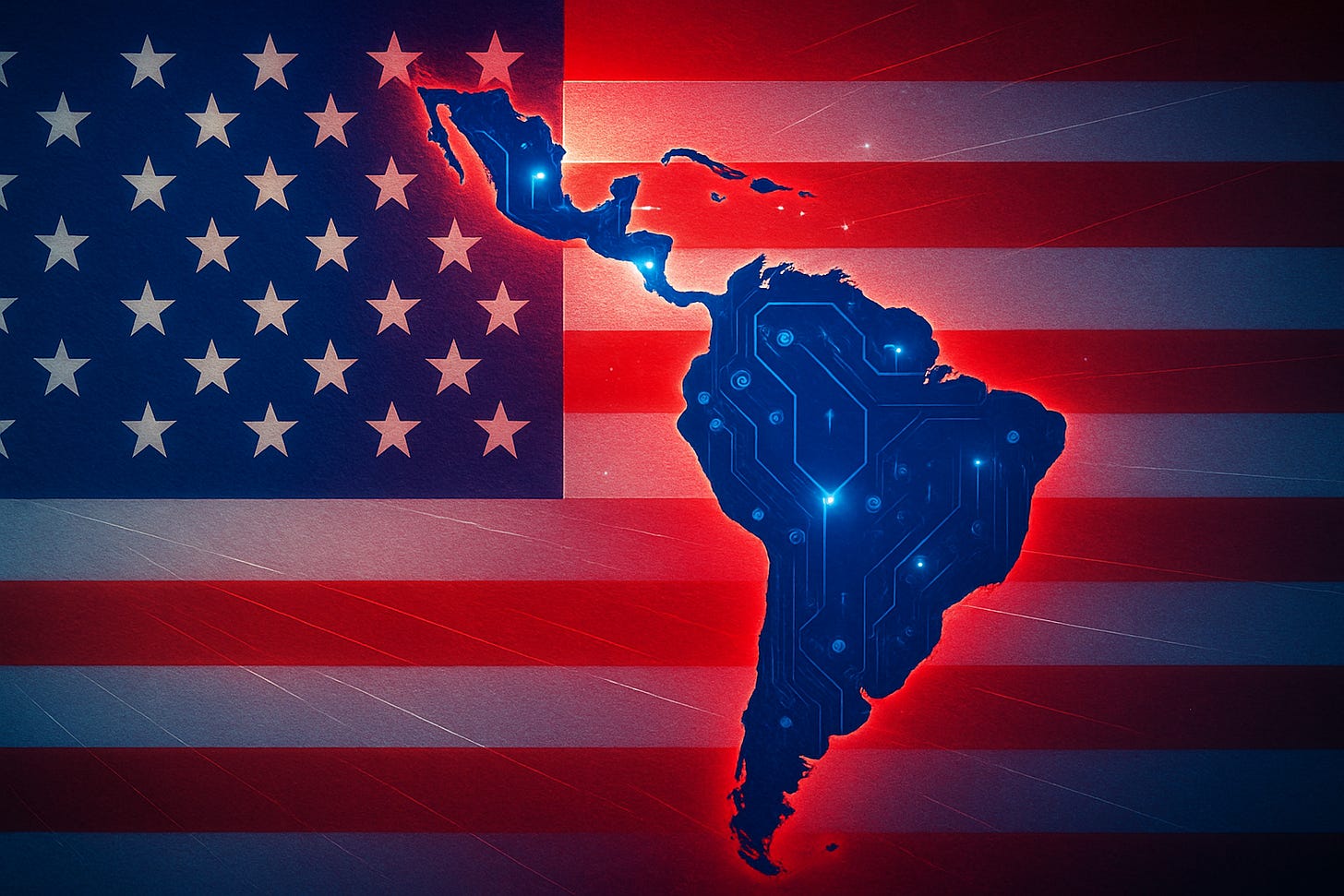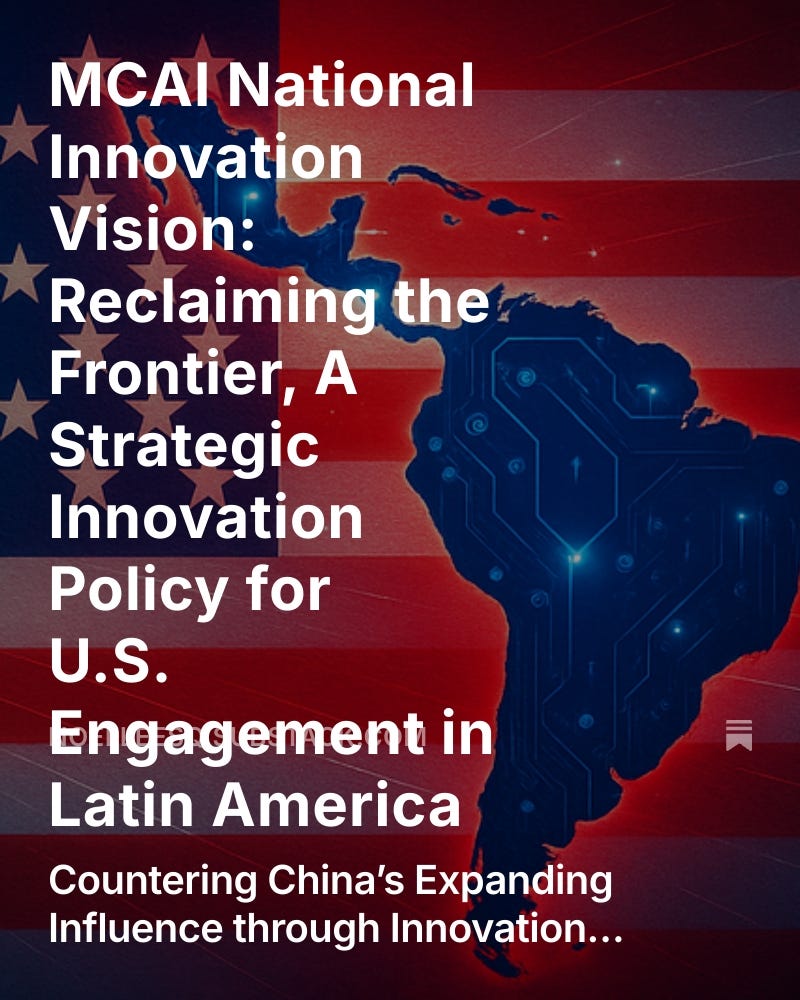MCAI National Innovation Vision: Reclaiming the Frontier, A Strategic Innovation Policy for U.S. Engagement in Latin America
Countering China’s Expanding Influence through Innovation-Driven Diplomacy and Economic Foresight
I. The Strategic Gap: China’s BRI Expansion in the Western Hemisphere
Over the last decade, the People’s Republic of China steadily expanded its economic and strategic influence in Latin America, leveraging the Belt and Road Initiative (BRI) to finance infrastructure, extract resources, and secure critical market footholds in Argentina, Brazil, Venezuela, and beyond. Through state-owned banks and policy-backed projects, China has filled a vacuum left by U.S. retrenchment and fragmented regional strategy. Latin American nations, hungry for investment and often locked out of Western capital markets, have turned eastward.
China’s approach is transactional but cloaked in long-term ambition. Port leases, lithium access, and energy deals intertwine commercial objectives with geopolitical leverage. The U.S., by contrast, lacks a unified policy that integrates innovation, diplomacy, and trade into a coherent hemispheric strategy.
Compounding the problem is the lack of U.S. investment in regional multilateral institutions capable of counterbalancing China's influence. The Inter-American Development Bank (IDB) and Organization of American States (OAS) remain underleveraged. Instead of providing scalable regional support, the U.S. has relied on bilateral aid and episodic diplomacy.
Furthermore, China has combined its infrastructure projects with cultural and educational programs like Confucius Institutes, establishing long-term soft power channels. While the quality of these projects is debated, their consistency creates loyalty.
Insight: Without a recalibrated innovation-forward policy, the U.S. risks becoming a peripheral actor in a region where it once set the terms.
Source: Council on Foreign Relations, "China’s Influence in Latin America," https://www.cfr.org/backgrounder/china-influence-latin-america-argentina-brazil-venezuela-security-energy-bri.
II. Innovation as Foreign Policy: A Framework for Strategic Reengagement
The next phase of U.S. foreign policy must treat innovation as a tool of diplomacy and alliance-building. Latin America is not just a geopolitical front; it is an emerging testbed for clean energy, digital infrastructure, biotech, and AI applications.
Key Strategic Levers:
Digital Infrastructure Partnership: Launch a Western Hemisphere Digital Sovereignty Initiative to provide open-access, secure alternatives to Chinese telecom investments (e.g., Huawei). A public-private coalition could deploy open-source 5G networks, train local engineers, and create interoperable systems aligned with democratic standards.
Green Energy Alliances: Co-develop regional lithium value chains, offering financing and technology partnerships in exchange for environmental and governance standards. American firms can collaborate with Andean governments on sustainable mining, battery storage, and EV ecosystems.
AI and Data Trust Compacts: Pilot data-sharing compacts with countries like Brazil and Colombia that align on democratic data governance models. These agreements should prioritize privacy, digital rights, and joint AI R&D.
Start-Up Diplomacy: Create a U.S.-Latin America Innovation Fund to seed cross-border entrepreneurship in education, healthcare, agtech, and fintech. Joint accelerator programs and startup visa pathways can embed reciprocity into talent mobility.
These efforts must be framed as partnerships, not paternalism. Latin American nations want co-development, not conditionality. The U.S. must lead with humility and strategic clarity.
To build bipartisan support, the U.S. should engage its business community—including chambers of commerce, innovation councils, and multinational firms—as key stakeholders in a hemispheric innovation strategy. When economic opportunity aligns with strategic foresight, durable policy coalitions become more feasible across party lines.
Insight: Embedding innovation inside U.S. regional engagement turns passive alliances into co-developed futures.
III. Institutional Alignment: From Defense to Development to Trust
A forward-looking policy must blend national security interests with long-term development goals. This requires interagency collaboration between USAID, the DFC, the State Department, and the National Security Council.
Proposed Coordination Mechanisms:
NSC-Led Western Hemisphere Innovation Task Force: Integrate tech, trade, and diplomacy into one rapid-response unit. This task force should include experts from the Department of Energy, Commerce, and Defense to ensure cross-sector coherence.
DFC Flexibility Act: Allow more risk-tolerant investments in frontier markets like the Amazon basin. Adjust statutory constraints to allow investment in early-stage infrastructure, microgrid deployment, and civic tech.
Public-Private Bridge Initiatives: Mobilize U.S. tech firms to build trust-based partnerships in education and digital health. Example: deploy edtech and telehealth pilots in underserved regions with U.S. and Latin American university partners.
AI-Diplomacy Training Corps: Equip foreign service officers with AI fluency and design thinking tools to navigate tech-driven diplomacy.
Equally important is sustained dialogue with civil society. Latin America has a vibrant network of indigenous, feminist, environmental, and academic groups that can provide feedback loops and cultural calibration.
Insight: The legitimacy of U.S. presence will not be based on ideology, but on whether it helps Latin Americans build resilient futures.
Conclusion: A Policy of Generational Investment
China is not winning in Latin America because it is beloved. It is winning because it is present, consistent, and willing to build. To compete, the U.S. must become not a lender of last resort but a partner of first choice. American innovation policy must evolve into a diplomacy of shared foresight—one that blends ethics with execution, and capital with coherence.
This is not just about competing with China. It is about reclaiming a shared hemispheric future. Latin America will shape the 21st-century narrative around clean energy, data governance, climate resilience, and cultural sovereignty. The U.S. has the opportunity to co-author that future—but only if it acts now, with creativity and conviction.
Next Steps:
Convene a Western Hemisphere Innovation Summit with leaders from government, tech, academia, and civil society.
Reauthorize and expand the BUILD Act with innovation-focused guardrails.
Embed innovation clauses in trade and climate agreements with regional partners.
Appoint a Special Envoy for Innovation Diplomacy in the Americas.
Insight: American leadership in the region will not be restored by nostalgia or containment—but by vision, trust, and innovation-led alignment. The window to act is closing, but the frontier remains open.




